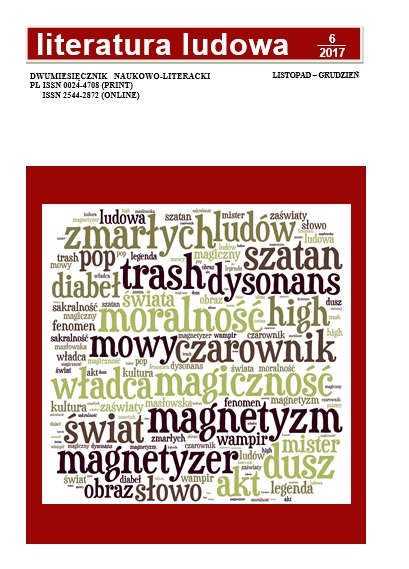ANTHROPOLOGICAL AND FOLK ASPECTS OF THE CREATION OF THE MAGNETISER CHARACTER IN THE WORKS OF ERNST THEODOR AMADEUS HOFFMAN AND JOZEF DZIERZKOWSKI
DOI:
https://doi.org/10.12775/LL.6.2017.002Keywords
Dzierzkowski, Hoffmann, Mesmer, magnetyzm, magnetyzer, romantyzm, wierzenia ludoweAbstract
The fascination with magnetism, both on the scientific and literary levels, was a phenomenon always inextricably connected to Romanticism. Magnetism and the mysterious figure of the magnetiser were a subject of interest for many Romantic writers, including E.T.A. Hoffman and Jozef Dzierzkowski. Both writers made the magnetic doctor their main protagonist. The discourse about magnetic cures became a constitutive issue in their musings. This article offere an analysis of the portraits of the magnetisers in Magnetiseur (1814) by E.T.A. Hoffmann and in The Magnetic Doctor (1844) by Józef Dierzakowski. Its goal is not only to present the title characters in relation to the assumptions of the Romantic anthropology developing at the beginning of the 19th century, but also to show that the elements derived from folklore, which was used by both writers in the creation of the image of the magnetiser, have a crucial influence on the birth of the (urban) legend connected to this figure.References
Hoffmann, E.T.A. (1958). Magnetyzer. W: Opowieści fantastyczne (przeł. Jerzy Ficowski i in.). Warszawa: Czytelnik.
Dzierzkowski J. (1976.). Lekarz magnetyczny. W: Polska nowela fantastyczna, red. J. Tuwim, t. 1, Kraków.
Abend S., Amtweiler, W. (2001). Götter in Weiß. Arztmythen in der Kunst W: Dominik Gross D. (red.): Medizingeschichte in Schlaglichtern: Beiträge des "Rheinischen Kreises der Medizinhistoriker“. Kassel: kassel university press, 363-376.
„Der reisende Teufel” (IX), 28. 04. 1828.
Bachórz, J., Kowalczykowa A. (red.) (1991). Słownik literatury polskiej XIX wieku. Wrocław: Zakład Narodowy im. Ossolińskich.
Borowy, W. (1920). Dziady a magnetyzm i teozofia. „Tygodnik Ilustrowany” 19, 364-366.
Braun, P. (2004). E.T.A. Hoffmann Dichter, Zeichner, Musiker, Biographie. Darmstadt: Wissenschaftliche Buchgesellschaft.
Brednich, R. W. (red.) (1990). Die Spinne in der Yucca Palme. Sagenhafte Geschichten von heute, München: Becksche Reihe.
Buck, M. R. (1865). Medicinischer Volksglauben u. Volksaberglauben aus Schwaben: eine kulturgeschichtliche Skizze. Ravensburg: Verlag der Dorn’schen Buchhandlung.
Carus, C. G. (1846). Psyche. Zur Entwicklungsgeschichte der Seele. Pforzheim: Flammer und Hoffmann.
Chruściński, K. (1965). „Hoghartyzm” i „hoffmanizm” w drobnych utworach narracyjnych Józefa Dzierzkowskiego z lat 1838-1844. Gdańskie Zeszyty Humanistyczne VIII, 165-75.
Chruściński, K. (1970). Józef Dzierzkowski: pisarz i działacz polityczny okresu międzypowstaniowego (1831-1863): Gdańsk: GTN.
Czeczot, K. (2016). Magnetyzm. Warszawa: Instytut Badań Literackich PAN
D.e.n. (pseud.) (1865). Józef Dzierzkowski. Przyjaciel domowy: pismo zbiorowe dla gospodarzy, 26, 101-102.
Fr. II. L (pseud.) (1865). Józef Dzierzkowski. Jana Jaworskiego kalendarz polski ilustrowany na rok zwyczajny 1865,zebrany staraniem redakcji gazety rolniczej. Warszawa: Nakładem i drukiem wydawcy, 11-13.
Goethe, J.W. von (1841). Faust: Eine Tragödie. Erster Theil. London: Herrmann Pfarge.
Haase, F. (1939). Volksglaube und Brauchtum der Ostslaven. Breslau: Verlag Gerhard Martin.
Jakowska K. Podręczny słownik pisarzy polskich. Józef Dzierzkowski Wiedza Powszechna, 2006, s 124-125
Janion, M. (1969). Romantyzm: Studia o ideach i stylu. Warszawa: Pánstwowy Instytut Wydawniczy.
Janion, M. (2002). Wampir: biografia symboliczna. Gdańsk: Słowo/obraz terytoria.
Kremer, D. (2007). Romantik: Stuttgart/Weimar: Verlag J. B. Metzler.
Kubacki W. (1951). Arcydramat Mickiewicza, Studia nad III częścią Dziadów, Kraków: M. Kot.
Kozakiewicz, S.. (1958). Ignacy Gierdziejewski. Wrocław: Zakład Narodowy im. Ossolińskich.
Kupfer, A. (2006). Die künstlichen Paradiese: Rausch und Realität seit der Romantik. Ein Handbuch. Stuttgart, Weimar: Verlag J. B. Metzler.
Mesmer, A. (1814). Mesmerismus.oder System der Wechselwirkungen, Theorie und Anwendung des thierischen Magnetismus (przeł. K. C. Wolfart). Berlin: Nikolaische Buchhandlung.
Moszyński K. (1967). Kultura ludowa Słowian: t. 2. Kultura duchowa. Warszawa: Ksia̜źka i Wiedza.
Petzoldt, L. (1989). Dämonenfurcht und Gottvertrauen. Zur Geschichte und Erforschung unserer Volkssagen.Darmstadt: Wissenschaftliche Buchgesellschaft.
Płonka-Syroka, B. (1990). Recepcja doktryn medycznych przełomu XVIII i XIX wieku w polskich ośrodkach akademickich, w latach 1784-1863. Wrocław: Zakład Narodowy im. Ossolińskich.
Podgórska, B., Podgórski A. (2005) Wielka księga demonów polskich: leksykon i antologia demonologii ludowej. Katowice: KOS.
Rosnowska J. Związki twórczości Dzierzkowskiego z literaturą i sztuką Zachodu. Pamiętnik Literacki. Czasopismo kwartalne poświęcone historii i krytyce literatury polskiej 58 (1), 27-65.
Schneider, M. (2013): Wissende des Unbewussten: Romantische Anthropologie und Ästhetik im Werk Richard Wagners. Berlin/Boston: Walter de Gruyter.
Schubert, G.H. (1840). Ansichten von der Nachtseite der Naturwissenschaft. Dresden, Leipzig: Arnoldische Buchhandlung.
Siebenpfeifer, H (2010). Messmerismus. Magnetismus. W: Kremmer, D. (red.) E.T.A. Hoffmann. Leben – Werk – Wirkung. Berlin, New York: de Gruyter.
Simonides, D. (1987). Moderne Sagenbildung im polnischen Großstadtmilieu. Fabula, 28 , 269-278.
Schweizer, S. (2008). Anthropologie der Romantik: Körper, Seele und Geist; anthropologische Gottes-, Welt- und Menschenbilder der wissenschaftlichen Romantik. Paderborn: F. Schöningh.
Stone, M. (2006). Energievampire: erkennen, meiden, abwehren. München: Integral Verlag.
Ruff, M. (2003). Zauberpraktiken als Lebenshilfe: Magie im Alltag vom Mittelalter bis heute Frankfurt, New York: Campus Verlag.
Russel, J.B. (2000). Biographie des Teufels: das radikal Böse und die Macht des Guten in der Welt (przeł. S. Grabmayr, M. Pitner). Köln, Wien, Weimar: Böhlau Verlag.
Tęcza, K. (1987): Zjawy i strachy polskie, Jelenia Góra: nakład autora.
Downloads
Published
How to Cite
Issue
Section
License
1. The authors give the publisher (Polish Ethnological Society) non-exclusive license to use the work in the following fields:a) recording of a Work / subject of a related copyright;
b) reproduction (multiplication) Work / subject of a related copyright in print and digital technique (ebook, audiobook);
c) marketing of units of reproduced Work / subject of a related copyright;
d) introduction of Work / object of related copyright to computer memory;
e) dissemination of the work in an electronic version in the formula of open access under the Creative Commons license (CC BY - ND 3.0).
2. The authors give the publisher the license free of charge.
3. The use of the work by publisher in the above mentioned aspects is not limited in time, quantitatively nor territorially.
Stats
Number of views and downloads: 529
Number of citations: 0



